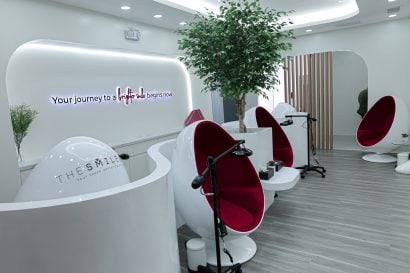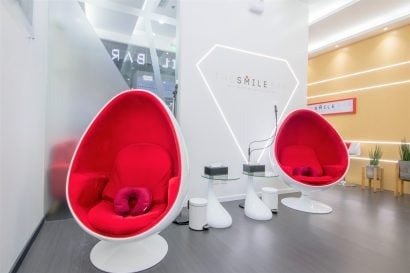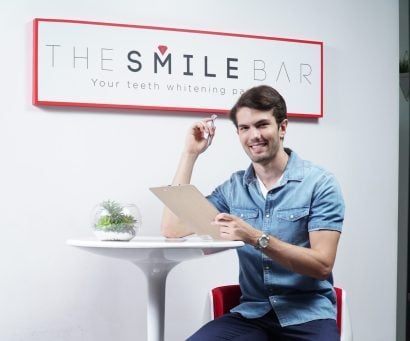If you have sensitive teeth, you might wonder whether bleaching is safe, and that’s a very good question.
Traditional bleaching treatments often use high concentrations of hydrogen peroxide, which can temporarily irritate enamel and make teeth feel sensitive.
Fortunately, modern LED whitening systems, like those offered at The Smile Bar Philippines, use a low-peroxide, pH-balanced gel that gently lifts stains without causing pain or discomfort.
Follow-Up Questions
Is teeth bleaching safe if you already have sensitive teeth?
- It depends on the method used. Conventional bleaching with strong peroxide can worsen sensitivity or gum irritation, especially if done too often. Choosing a professional treatment designed for sensitive teeth is key.
What’s the safer alternative?
- LED whitening, which uses a gentle, cool light to activate a low-peroxide gel. This method is clinically proven to minimize discomfort while still delivering visible results.
Can bleaching damage enamel?
- When overused or done with strong chemicals, it can weaken and thin out the enamel and increase discomfort. That’s why gentler whitening options, like LED systems, are preferred for sensitive smiles.
What should I do before whitening if I have sensitivity?
- Use a desensitizing toothpaste for one to two weeks before treatment and inform your specialist about your sensitivity history. If you’re looking for a clinic experienced in treating sensitive teeth, The Smile Bar offers LED whitening designed specifically for comfort, ensuring effective results without pain or irritation.
Why Teeth Bleaching Can Be Risky for Sensitive Teeth
Teeth bleaching typically involves 15–35% hydrogen or carbamide peroxide to remove deep stains within the enamel.
While effective, these agents can dehydrate the enamel temporarily and expose microscopic dentin channels, triggering pain or tingling sensations, especially in people with thinner enamel or gum recession.
In tropical countries like the Philippines, acidic diets, frequent coffee or soda consumption, and enamel wear make teeth even more prone to sensitivity.
That’s why local dental professionals often recommend LED whitening as a safer, more comfortable alternative.
How LED Whitening Works (and Why It’s Gentler)
LED whitening uses low-peroxide, pH-balanced gel that removes surface stains without dehydrating the enamel.
Unlike traditional bleaching, it doesn’t generate heat or dryness, making it ideal for those prone to sensitivity.
At The Smile Bar Philippines, the LED system is:
- Gentle on enamel and gums
- Clinically safe for sensitive teeth
- Quick, with visible results in 20 to 40 minutes
Most clients see up to 9 shades of improvement after one session, without discomfort.
Clinical Insight: Why Bleaching Triggers Sensitivity
Studies show that around half of bleaching patients experience mild to moderate sensitivity after treatment. This happens because peroxide temporarily alters the fluid balance within enamel, exposing nerve endings to external stimuli.
LED whitening, by contrast, uses a stable, pH-neutral gel activated at low temperature, avoiding enamel dehydration and heat buildup.
Comparison: Bleaching vs. LED Whitening for Sensitive Teeth
| Whitening Method | Active Ingredient | Sensitivity Risk | Safe for Sensitive Teeth? |
|---|---|---|---|
| Traditional Bleaching | 15–35% hydrogen or carbamide peroxide | Moderate–High | May cause irritation or enamel dehydration |
| Laser Whitening | High peroxide with heat activation | Moderate | Possible short-term tingling or sensitivity |
| LED Whitening (The Smile Bar) | Low-peroxide, pH-balanced gel | Very Low | Safe, comfortable, and gentle |
| At-Home Whitening Strips | Variable peroxide concentration | High | Not recommended for sensitive teeth |
💡 LED whitening offers visible results without the risk of sensitivity common with traditional bleaching.
When Bleaching Should Be Avoided
You should postpone or avoid bleaching if you:
- Have gum recession or exposed roots
- Experience chronic sensitivity or enamel erosion
- Have cracks, cavities, or recent restorations
- Are pregnant or breastfeeding
For these cases, LED whitening is the preferred choice because it is non-invasive, safe, and suitable for almost everyone.
Preparing for Bleaching Whitening When You Have Sensitivity
To make your whitening session more comfortable:
- Brush with desensitizing toothpaste for 7 to 10 days before your visit
- Avoid very hot or cold drinks 24 hours before treatment
- Schedule your session with a clinic experienced in treating sensitive teeth
Real Stories from The Smile Bar Sensitive Clients in Manila
Mia, 31 (Taguig): “I avoided whitening for years because my teeth are sensitive. I tried LED whitening at The Smile Bar and it was surprisingly comfortable, zero pain and great results.”
Rico, 40 (Makati): “Laser bleaching left me sore for days. Switching to LED whitening changed everything, no sting, no heat, just a brighter smile.”
Pat, 27 (Quezon City): “Even with sensitive teeth, LED whitening was fast and painless. It’s my go-to before events now.”
Conclusion TL;DR
Traditional bleaching can cause discomfort if you have sensitive teeth because of its strong peroxide concentration. However, LED whitening offers a safer, gentler option that effectively brightens your smile without irritation or pain.
At The Smile Bar Philippines, treatments use a low-peroxide, pH-balanced gel proven to deliver up to 9 shades lighter safely and comfortably.
Ready to Whiten Without the Pain?
If you have sensitive teeth and want a whiter smile, skip the harsh bleaching and go for LED.
Book your session at The Smile Bar Philippines in BGC, Vertis North, or Molito Alabang and enjoy a visibly brighter smile, comfortably.
Frequently Asked Questions
Does bleaching always cause sensitivity?
- Not always, but it’s common when high-peroxide gels are used or when the enamel is already thin.
Why is LED whitening safer?
- It uses a cool, low-peroxide gel that minimizes dehydration and avoids irritation of the gums and enamel.
Can I whiten if I have very sensitive teeth?
- Yes, as long as you choose a low-peroxide LED whitening system designed for comfort.
How long do LED whitening results last?
- Typically 3 to 6 months, depending on diet, habits, and oral care.






